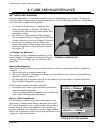
Companion Owner's Manual: GC240, GC340, GC440
Companion 30
Resetting the Main Circuit Breaker
1. If the main circuit breaker trips as a result of run-down batteries or because of a
temporary overload, reset the circuit breaker:
2. Wait ten minutes or so for the motor control board to return to the normal operating
temperature range.
3. Make certain that the key switch is set to the “Off” position.
4. Press in on the main circuit breaker reset button. See figure 30.
NOTE: If the main circuit breaker continues to trip, there is probably an
underlying electrical fault that needs attention.
• Contact your authorized Golden Technologies, Inc. dealer.
•
Do not keep resetting the main circuit breaker without correcting the underlying
electrical problem.
DIAGNOSTICS
The diagnostics feature of your Golden Companion’s microprocessor based motor control
board functions as follows:
• Any fault condition on the controller or on an associated system will cause the Power In-
dicator LED to flash.
• The flashing of the LED occurs as one flash or as a series of flashes separated by a two-
second pause.
• The number of flashes in each series is referred to as the “Flash Code.”
• The flash code indicates the nature of the condition or fault.
THE FLASH CODES
1 Flash
• Indicates that the battery voltage (with the throttle control lever in the neutral position)
is below 19 volts.
• The batteries need to be charged.
• Your Companion will continue to operate at reduced speeds until the voltage falls to 17.5
volts.
• As the voltage drops you will experience a power loss.
Remedy: Charge your Companion’s batteries. See “Batteries and Charging” in this
section.
2 Flashes
• Indicates that the battery voltage has dropped to 17.5 volts.
• At this voltage your scooter will cease operation.
• If you have charged the batteries and the condition continues, one or both of the
scooter’s batteries may be at fault.
• The continuance of this condition after you have charged your Companion’s batteries
may also indicate a problem with the battery charger.
X. CARE AND MAINTENANCE


















